MKT01760 Tourism Planning: A Policy Response to Climate Change
VerifiedAdded on 2023/06/08
|12
|4381
|285
Report
AI Summary
This report presents a position statement on Tourism Australia's role in mitigating climate change impacts on the tourism sector. It highlights the organization's responsibilities and values, emphasizing the need for policies addressing GHG emissions and promoting Destination Management Operations. The background context discusses the challenges faced by Australian tourism due to climate change, including coral bleaching, coastal flooding, and rising sea levels, further elaborating on the economic, demographic, and environmental drivers of climate change, focusing on income inequality, population growth, and GHG emissions. A statement of need underscores the importance of governmental and business interventions to enforce emission limits and promote sustainable practices, identifying key stakeholders and relevant international agreements. Challenges to policy implementation, such as political opposition, are also acknowledged, setting the stage for proposed solutions.
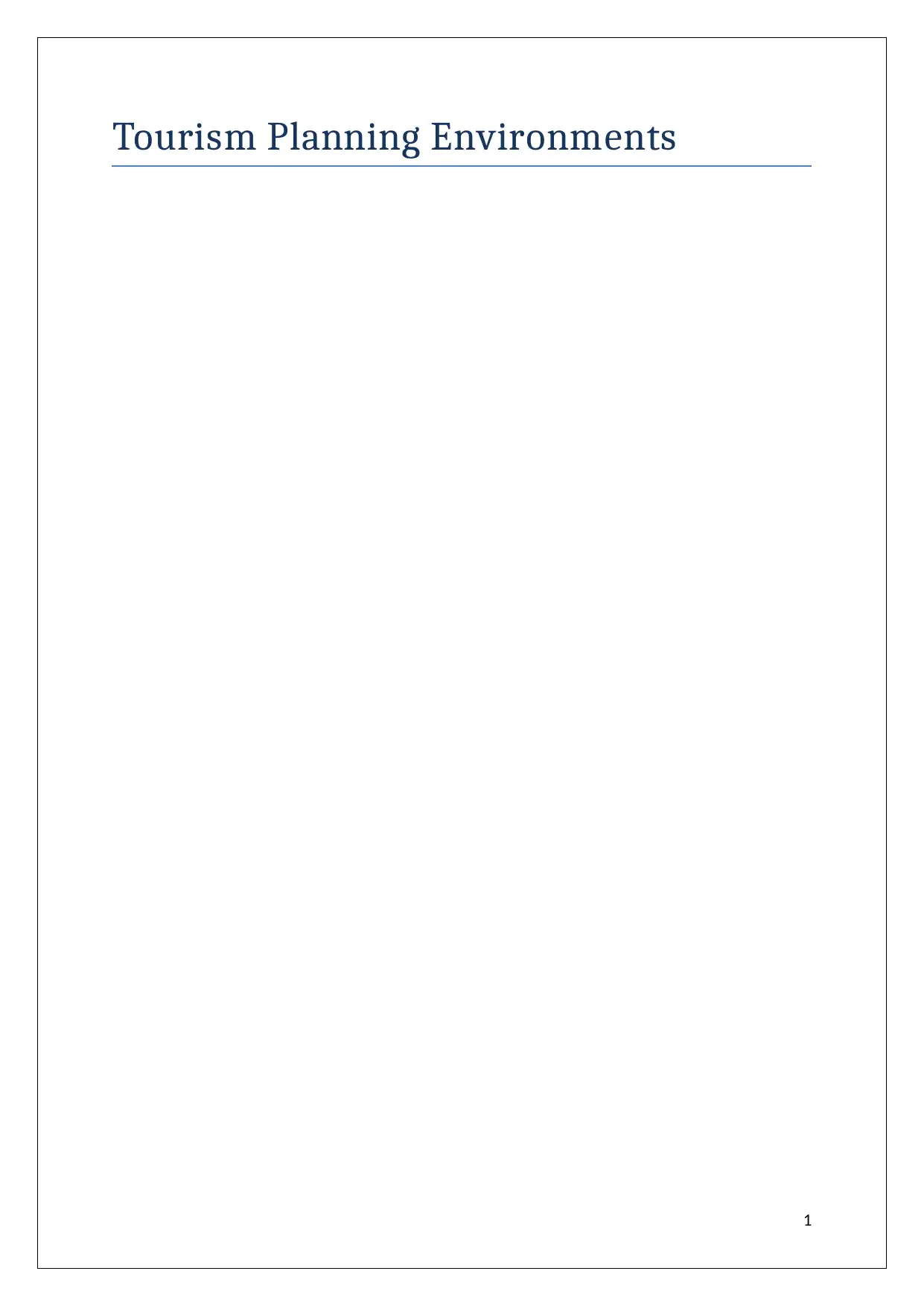
Tourism Planning Environments
1
1
Paraphrase This Document
Need a fresh take? Get an instant paraphrase of this document with our AI Paraphraser
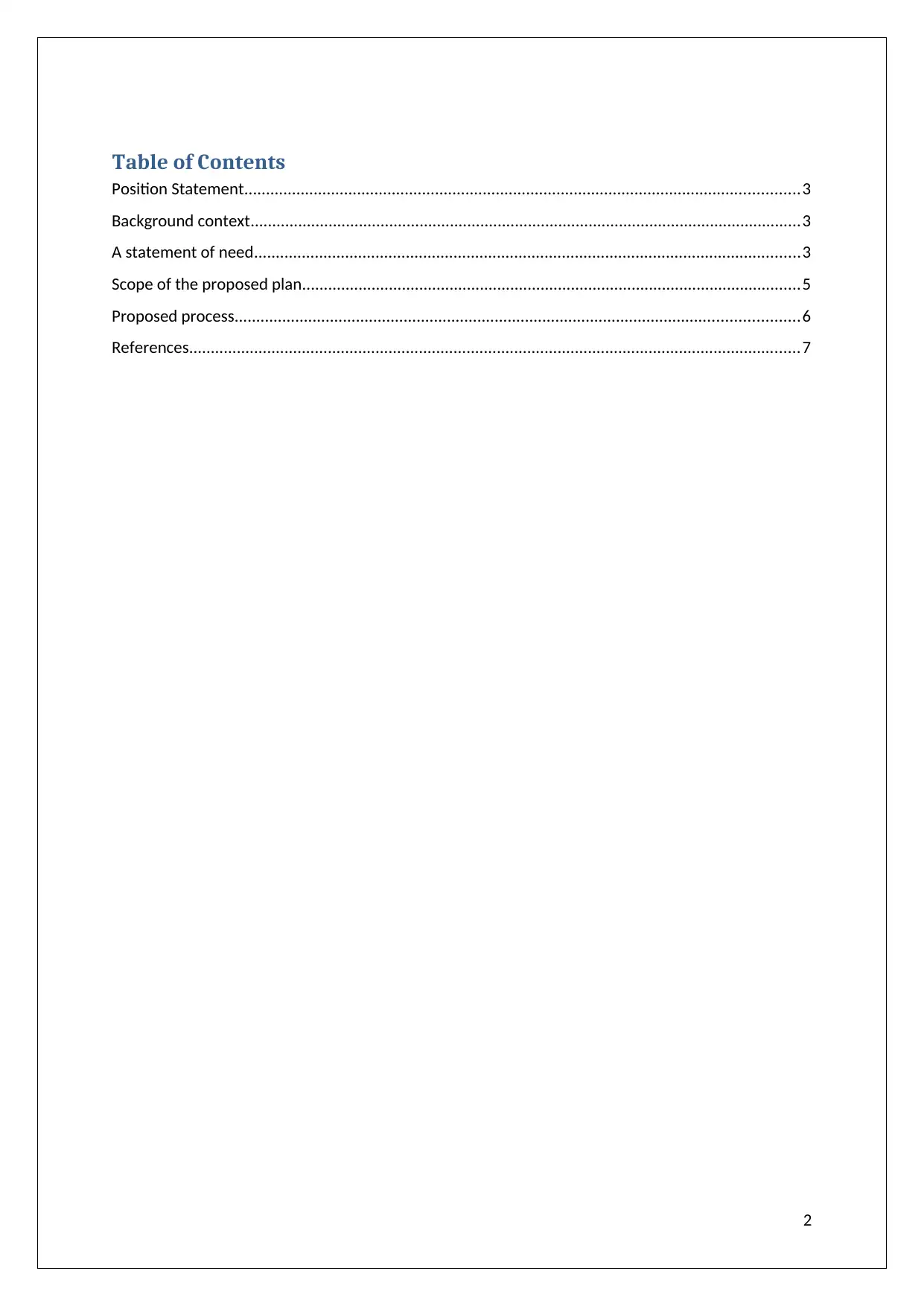
Table of Contents
Position Statement................................................................................................................................3
Background context...............................................................................................................................3
A statement of need..............................................................................................................................3
Scope of the proposed plan...................................................................................................................5
Proposed process..................................................................................................................................6
References.............................................................................................................................................7
2
Position Statement................................................................................................................................3
Background context...............................................................................................................................3
A statement of need..............................................................................................................................3
Scope of the proposed plan...................................................................................................................5
Proposed process..................................................................................................................................6
References.............................................................................................................................................7
2
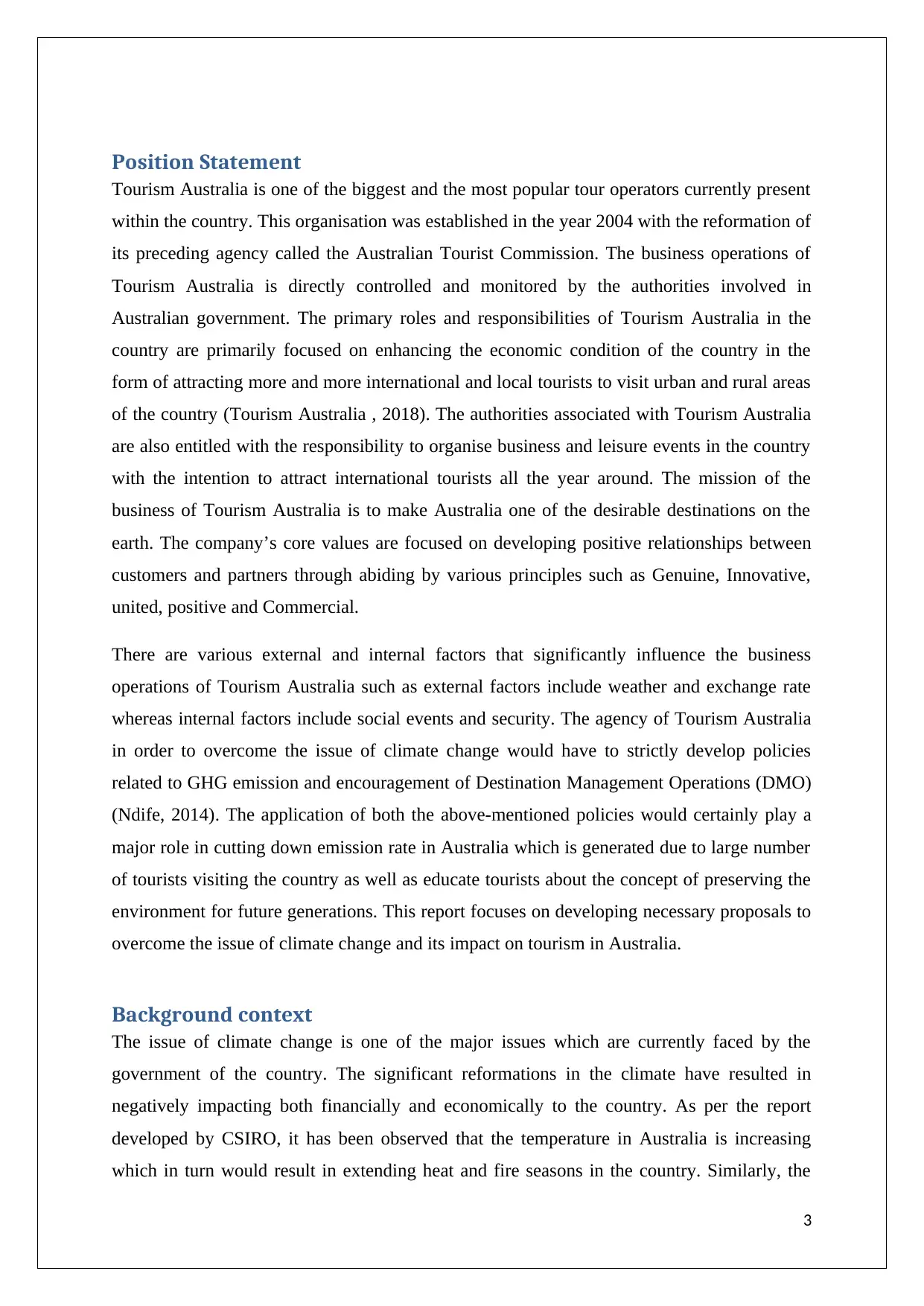
Position Statement
Tourism Australia is one of the biggest and the most popular tour operators currently present
within the country. This organisation was established in the year 2004 with the reformation of
its preceding agency called the Australian Tourist Commission. The business operations of
Tourism Australia is directly controlled and monitored by the authorities involved in
Australian government. The primary roles and responsibilities of Tourism Australia in the
country are primarily focused on enhancing the economic condition of the country in the
form of attracting more and more international and local tourists to visit urban and rural areas
of the country (Tourism Australia , 2018). The authorities associated with Tourism Australia
are also entitled with the responsibility to organise business and leisure events in the country
with the intention to attract international tourists all the year around. The mission of the
business of Tourism Australia is to make Australia one of the desirable destinations on the
earth. The company’s core values are focused on developing positive relationships between
customers and partners through abiding by various principles such as Genuine, Innovative,
united, positive and Commercial.
There are various external and internal factors that significantly influence the business
operations of Tourism Australia such as external factors include weather and exchange rate
whereas internal factors include social events and security. The agency of Tourism Australia
in order to overcome the issue of climate change would have to strictly develop policies
related to GHG emission and encouragement of Destination Management Operations (DMO)
(Ndife, 2014). The application of both the above-mentioned policies would certainly play a
major role in cutting down emission rate in Australia which is generated due to large number
of tourists visiting the country as well as educate tourists about the concept of preserving the
environment for future generations. This report focuses on developing necessary proposals to
overcome the issue of climate change and its impact on tourism in Australia.
Background context
The issue of climate change is one of the major issues which are currently faced by the
government of the country. The significant reformations in the climate have resulted in
negatively impacting both financially and economically to the country. As per the report
developed by CSIRO, it has been observed that the temperature in Australia is increasing
which in turn would result in extending heat and fire seasons in the country. Similarly, the
3
Tourism Australia is one of the biggest and the most popular tour operators currently present
within the country. This organisation was established in the year 2004 with the reformation of
its preceding agency called the Australian Tourist Commission. The business operations of
Tourism Australia is directly controlled and monitored by the authorities involved in
Australian government. The primary roles and responsibilities of Tourism Australia in the
country are primarily focused on enhancing the economic condition of the country in the
form of attracting more and more international and local tourists to visit urban and rural areas
of the country (Tourism Australia , 2018). The authorities associated with Tourism Australia
are also entitled with the responsibility to organise business and leisure events in the country
with the intention to attract international tourists all the year around. The mission of the
business of Tourism Australia is to make Australia one of the desirable destinations on the
earth. The company’s core values are focused on developing positive relationships between
customers and partners through abiding by various principles such as Genuine, Innovative,
united, positive and Commercial.
There are various external and internal factors that significantly influence the business
operations of Tourism Australia such as external factors include weather and exchange rate
whereas internal factors include social events and security. The agency of Tourism Australia
in order to overcome the issue of climate change would have to strictly develop policies
related to GHG emission and encouragement of Destination Management Operations (DMO)
(Ndife, 2014). The application of both the above-mentioned policies would certainly play a
major role in cutting down emission rate in Australia which is generated due to large number
of tourists visiting the country as well as educate tourists about the concept of preserving the
environment for future generations. This report focuses on developing necessary proposals to
overcome the issue of climate change and its impact on tourism in Australia.
Background context
The issue of climate change is one of the major issues which are currently faced by the
government of the country. The significant reformations in the climate have resulted in
negatively impacting both financially and economically to the country. As per the report
developed by CSIRO, it has been observed that the temperature in Australia is increasing
which in turn would result in extending heat and fire seasons in the country. Similarly, the
3
⊘ This is a preview!⊘
Do you want full access?
Subscribe today to unlock all pages.

Trusted by 1+ million students worldwide
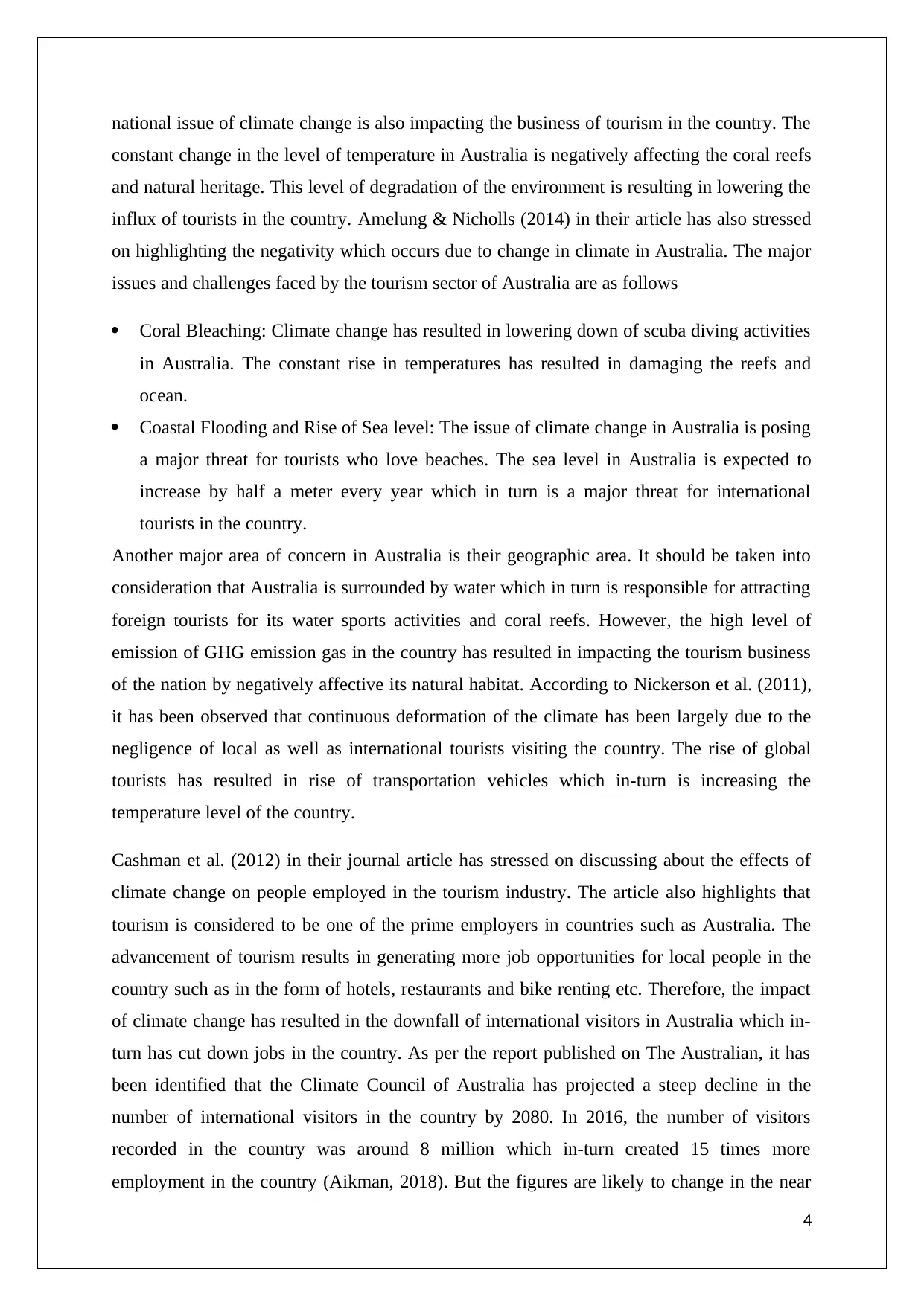
national issue of climate change is also impacting the business of tourism in the country. The
constant change in the level of temperature in Australia is negatively affecting the coral reefs
and natural heritage. This level of degradation of the environment is resulting in lowering the
influx of tourists in the country. Amelung & Nicholls (2014) in their article has also stressed
on highlighting the negativity which occurs due to change in climate in Australia. The major
issues and challenges faced by the tourism sector of Australia are as follows
Coral Bleaching: Climate change has resulted in lowering down of scuba diving activities
in Australia. The constant rise in temperatures has resulted in damaging the reefs and
ocean.
Coastal Flooding and Rise of Sea level: The issue of climate change in Australia is posing
a major threat for tourists who love beaches. The sea level in Australia is expected to
increase by half a meter every year which in turn is a major threat for international
tourists in the country.
Another major area of concern in Australia is their geographic area. It should be taken into
consideration that Australia is surrounded by water which in turn is responsible for attracting
foreign tourists for its water sports activities and coral reefs. However, the high level of
emission of GHG emission gas in the country has resulted in impacting the tourism business
of the nation by negatively affective its natural habitat. According to Nickerson et al. (2011),
it has been observed that continuous deformation of the climate has been largely due to the
negligence of local as well as international tourists visiting the country. The rise of global
tourists has resulted in rise of transportation vehicles which in-turn is increasing the
temperature level of the country.
Cashman et al. (2012) in their journal article has stressed on discussing about the effects of
climate change on people employed in the tourism industry. The article also highlights that
tourism is considered to be one of the prime employers in countries such as Australia. The
advancement of tourism results in generating more job opportunities for local people in the
country such as in the form of hotels, restaurants and bike renting etc. Therefore, the impact
of climate change has resulted in the downfall of international visitors in Australia which in-
turn has cut down jobs in the country. As per the report published on The Australian, it has
been identified that the Climate Council of Australia has projected a steep decline in the
number of international visitors in the country by 2080. In 2016, the number of visitors
recorded in the country was around 8 million which in-turn created 15 times more
employment in the country (Aikman, 2018). But the figures are likely to change in the near
4
constant change in the level of temperature in Australia is negatively affecting the coral reefs
and natural heritage. This level of degradation of the environment is resulting in lowering the
influx of tourists in the country. Amelung & Nicholls (2014) in their article has also stressed
on highlighting the negativity which occurs due to change in climate in Australia. The major
issues and challenges faced by the tourism sector of Australia are as follows
Coral Bleaching: Climate change has resulted in lowering down of scuba diving activities
in Australia. The constant rise in temperatures has resulted in damaging the reefs and
ocean.
Coastal Flooding and Rise of Sea level: The issue of climate change in Australia is posing
a major threat for tourists who love beaches. The sea level in Australia is expected to
increase by half a meter every year which in turn is a major threat for international
tourists in the country.
Another major area of concern in Australia is their geographic area. It should be taken into
consideration that Australia is surrounded by water which in turn is responsible for attracting
foreign tourists for its water sports activities and coral reefs. However, the high level of
emission of GHG emission gas in the country has resulted in impacting the tourism business
of the nation by negatively affective its natural habitat. According to Nickerson et al. (2011),
it has been observed that continuous deformation of the climate has been largely due to the
negligence of local as well as international tourists visiting the country. The rise of global
tourists has resulted in rise of transportation vehicles which in-turn is increasing the
temperature level of the country.
Cashman et al. (2012) in their journal article has stressed on discussing about the effects of
climate change on people employed in the tourism industry. The article also highlights that
tourism is considered to be one of the prime employers in countries such as Australia. The
advancement of tourism results in generating more job opportunities for local people in the
country such as in the form of hotels, restaurants and bike renting etc. Therefore, the impact
of climate change has resulted in the downfall of international visitors in Australia which in-
turn has cut down jobs in the country. As per the report published on The Australian, it has
been identified that the Climate Council of Australia has projected a steep decline in the
number of international visitors in the country by 2080. In 2016, the number of visitors
recorded in the country was around 8 million which in-turn created 15 times more
employment in the country (Aikman, 2018). But the figures are likely to change in the near
4
Paraphrase This Document
Need a fresh take? Get an instant paraphrase of this document with our AI Paraphraser
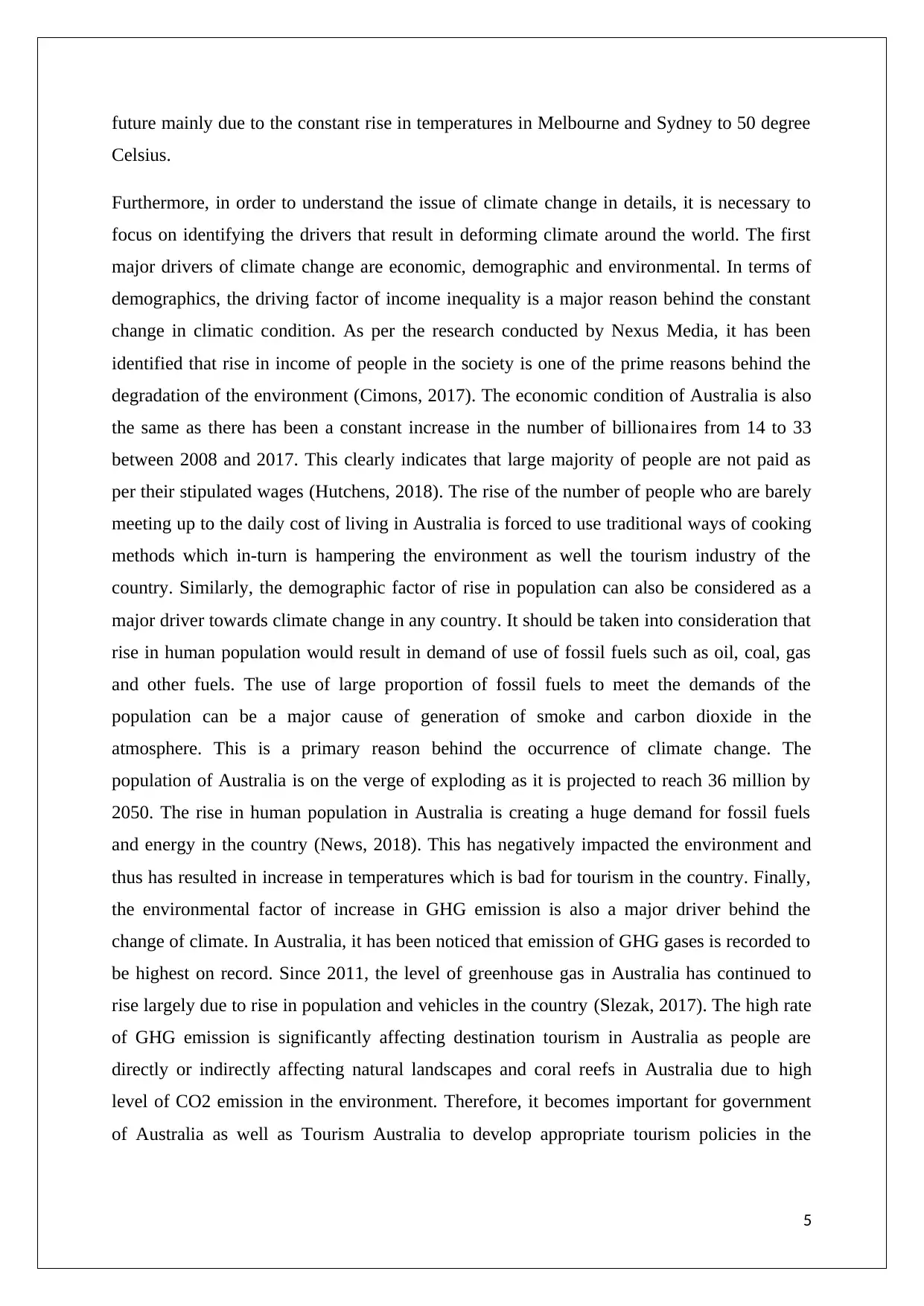
future mainly due to the constant rise in temperatures in Melbourne and Sydney to 50 degree
Celsius.
Furthermore, in order to understand the issue of climate change in details, it is necessary to
focus on identifying the drivers that result in deforming climate around the world. The first
major drivers of climate change are economic, demographic and environmental. In terms of
demographics, the driving factor of income inequality is a major reason behind the constant
change in climatic condition. As per the research conducted by Nexus Media, it has been
identified that rise in income of people in the society is one of the prime reasons behind the
degradation of the environment (Cimons, 2017). The economic condition of Australia is also
the same as there has been a constant increase in the number of billionaires from 14 to 33
between 2008 and 2017. This clearly indicates that large majority of people are not paid as
per their stipulated wages (Hutchens, 2018). The rise of the number of people who are barely
meeting up to the daily cost of living in Australia is forced to use traditional ways of cooking
methods which in-turn is hampering the environment as well the tourism industry of the
country. Similarly, the demographic factor of rise in population can also be considered as a
major driver towards climate change in any country. It should be taken into consideration that
rise in human population would result in demand of use of fossil fuels such as oil, coal, gas
and other fuels. The use of large proportion of fossil fuels to meet the demands of the
population can be a major cause of generation of smoke and carbon dioxide in the
atmosphere. This is a primary reason behind the occurrence of climate change. The
population of Australia is on the verge of exploding as it is projected to reach 36 million by
2050. The rise in human population in Australia is creating a huge demand for fossil fuels
and energy in the country (News, 2018). This has negatively impacted the environment and
thus has resulted in increase in temperatures which is bad for tourism in the country. Finally,
the environmental factor of increase in GHG emission is also a major driver behind the
change of climate. In Australia, it has been noticed that emission of GHG gases is recorded to
be highest on record. Since 2011, the level of greenhouse gas in Australia has continued to
rise largely due to rise in population and vehicles in the country (Slezak, 2017). The high rate
of GHG emission is significantly affecting destination tourism in Australia as people are
directly or indirectly affecting natural landscapes and coral reefs in Australia due to high
level of CO2 emission in the environment. Therefore, it becomes important for government
of Australia as well as Tourism Australia to develop appropriate tourism policies in the
5
Celsius.
Furthermore, in order to understand the issue of climate change in details, it is necessary to
focus on identifying the drivers that result in deforming climate around the world. The first
major drivers of climate change are economic, demographic and environmental. In terms of
demographics, the driving factor of income inequality is a major reason behind the constant
change in climatic condition. As per the research conducted by Nexus Media, it has been
identified that rise in income of people in the society is one of the prime reasons behind the
degradation of the environment (Cimons, 2017). The economic condition of Australia is also
the same as there has been a constant increase in the number of billionaires from 14 to 33
between 2008 and 2017. This clearly indicates that large majority of people are not paid as
per their stipulated wages (Hutchens, 2018). The rise of the number of people who are barely
meeting up to the daily cost of living in Australia is forced to use traditional ways of cooking
methods which in-turn is hampering the environment as well the tourism industry of the
country. Similarly, the demographic factor of rise in population can also be considered as a
major driver towards climate change in any country. It should be taken into consideration that
rise in human population would result in demand of use of fossil fuels such as oil, coal, gas
and other fuels. The use of large proportion of fossil fuels to meet the demands of the
population can be a major cause of generation of smoke and carbon dioxide in the
atmosphere. This is a primary reason behind the occurrence of climate change. The
population of Australia is on the verge of exploding as it is projected to reach 36 million by
2050. The rise in human population in Australia is creating a huge demand for fossil fuels
and energy in the country (News, 2018). This has negatively impacted the environment and
thus has resulted in increase in temperatures which is bad for tourism in the country. Finally,
the environmental factor of increase in GHG emission is also a major driver behind the
change of climate. In Australia, it has been noticed that emission of GHG gases is recorded to
be highest on record. Since 2011, the level of greenhouse gas in Australia has continued to
rise largely due to rise in population and vehicles in the country (Slezak, 2017). The high rate
of GHG emission is significantly affecting destination tourism in Australia as people are
directly or indirectly affecting natural landscapes and coral reefs in Australia due to high
level of CO2 emission in the environment. Therefore, it becomes important for government
of Australia as well as Tourism Australia to develop appropriate tourism policies in the
5
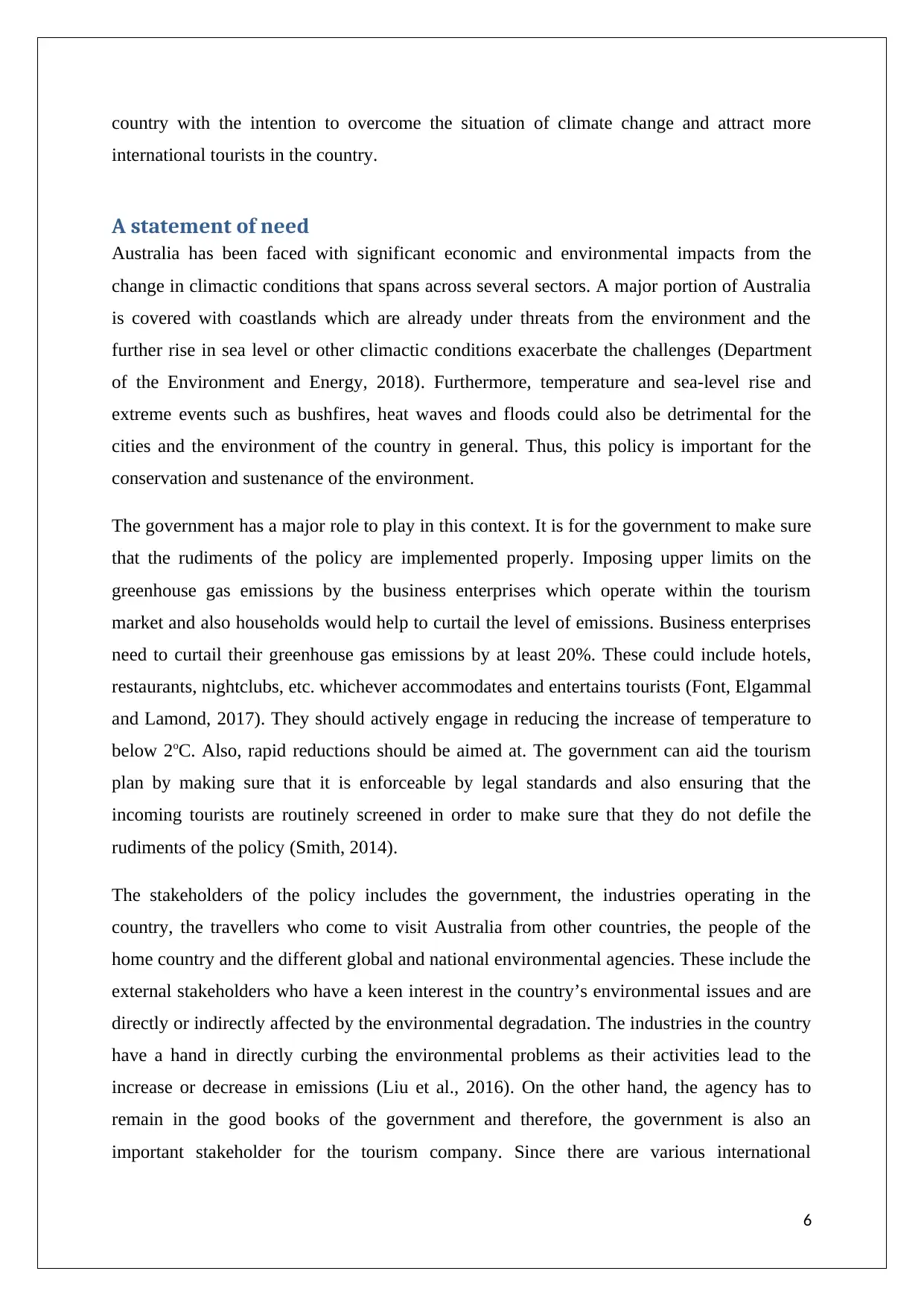
country with the intention to overcome the situation of climate change and attract more
international tourists in the country.
A statement of need
Australia has been faced with significant economic and environmental impacts from the
change in climactic conditions that spans across several sectors. A major portion of Australia
is covered with coastlands which are already under threats from the environment and the
further rise in sea level or other climactic conditions exacerbate the challenges (Department
of the Environment and Energy, 2018). Furthermore, temperature and sea-level rise and
extreme events such as bushfires, heat waves and floods could also be detrimental for the
cities and the environment of the country in general. Thus, this policy is important for the
conservation and sustenance of the environment.
The government has a major role to play in this context. It is for the government to make sure
that the rudiments of the policy are implemented properly. Imposing upper limits on the
greenhouse gas emissions by the business enterprises which operate within the tourism
market and also households would help to curtail the level of emissions. Business enterprises
need to curtail their greenhouse gas emissions by at least 20%. These could include hotels,
restaurants, nightclubs, etc. whichever accommodates and entertains tourists (Font, Elgammal
and Lamond, 2017). They should actively engage in reducing the increase of temperature to
below 2oC. Also, rapid reductions should be aimed at. The government can aid the tourism
plan by making sure that it is enforceable by legal standards and also ensuring that the
incoming tourists are routinely screened in order to make sure that they do not defile the
rudiments of the policy (Smith, 2014).
The stakeholders of the policy includes the government, the industries operating in the
country, the travellers who come to visit Australia from other countries, the people of the
home country and the different global and national environmental agencies. These include the
external stakeholders who have a keen interest in the country’s environmental issues and are
directly or indirectly affected by the environmental degradation. The industries in the country
have a hand in directly curbing the environmental problems as their activities lead to the
increase or decrease in emissions (Liu et al., 2016). On the other hand, the agency has to
remain in the good books of the government and therefore, the government is also an
important stakeholder for the tourism company. Since there are various international
6
international tourists in the country.
A statement of need
Australia has been faced with significant economic and environmental impacts from the
change in climactic conditions that spans across several sectors. A major portion of Australia
is covered with coastlands which are already under threats from the environment and the
further rise in sea level or other climactic conditions exacerbate the challenges (Department
of the Environment and Energy, 2018). Furthermore, temperature and sea-level rise and
extreme events such as bushfires, heat waves and floods could also be detrimental for the
cities and the environment of the country in general. Thus, this policy is important for the
conservation and sustenance of the environment.
The government has a major role to play in this context. It is for the government to make sure
that the rudiments of the policy are implemented properly. Imposing upper limits on the
greenhouse gas emissions by the business enterprises which operate within the tourism
market and also households would help to curtail the level of emissions. Business enterprises
need to curtail their greenhouse gas emissions by at least 20%. These could include hotels,
restaurants, nightclubs, etc. whichever accommodates and entertains tourists (Font, Elgammal
and Lamond, 2017). They should actively engage in reducing the increase of temperature to
below 2oC. Also, rapid reductions should be aimed at. The government can aid the tourism
plan by making sure that it is enforceable by legal standards and also ensuring that the
incoming tourists are routinely screened in order to make sure that they do not defile the
rudiments of the policy (Smith, 2014).
The stakeholders of the policy includes the government, the industries operating in the
country, the travellers who come to visit Australia from other countries, the people of the
home country and the different global and national environmental agencies. These include the
external stakeholders who have a keen interest in the country’s environmental issues and are
directly or indirectly affected by the environmental degradation. The industries in the country
have a hand in directly curbing the environmental problems as their activities lead to the
increase or decrease in emissions (Liu et al., 2016). On the other hand, the agency has to
remain in the good books of the government and therefore, the government is also an
important stakeholder for the tourism company. Since there are various international
6
⊘ This is a preview!⊘
Do you want full access?
Subscribe today to unlock all pages.

Trusted by 1+ million students worldwide
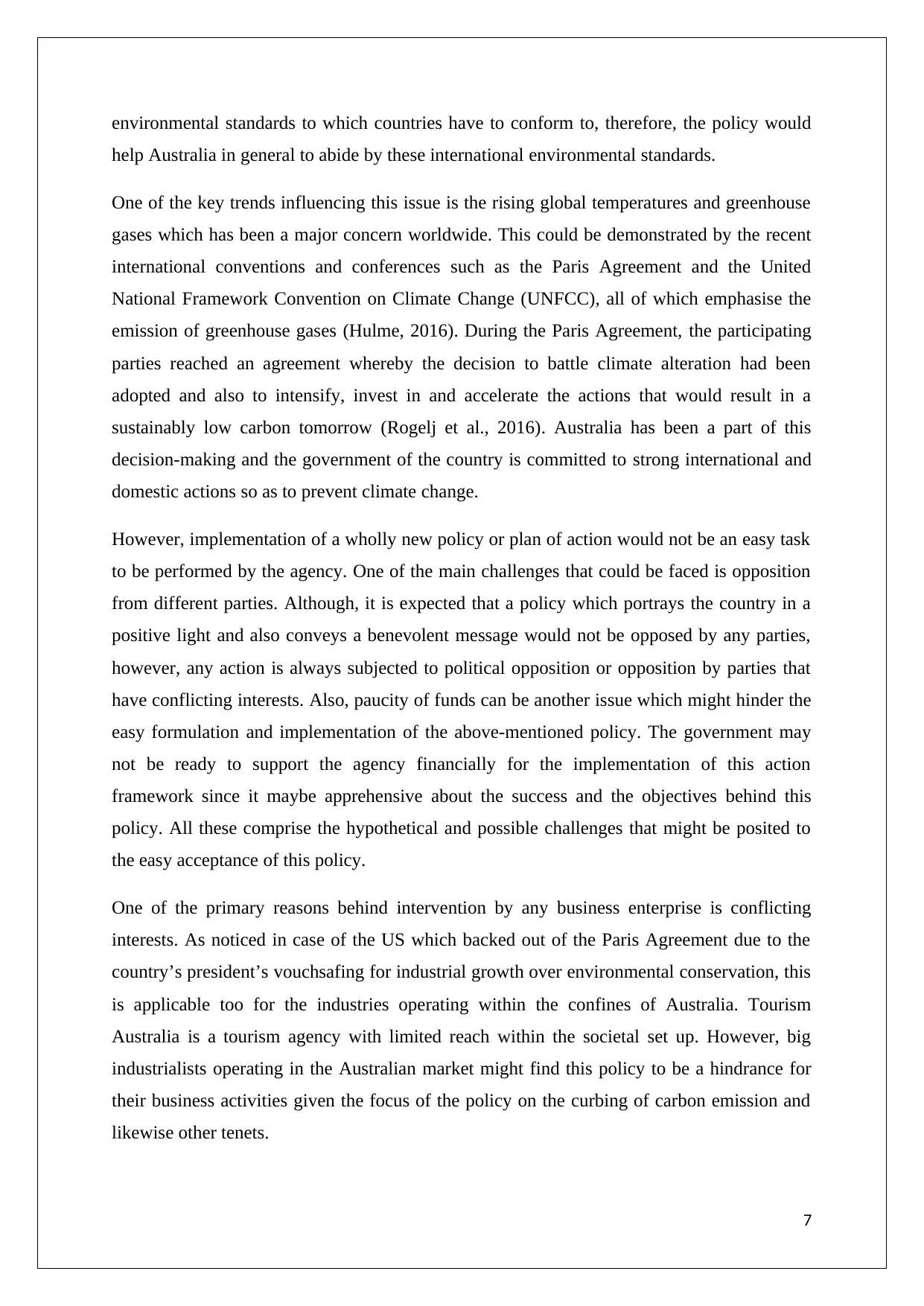
environmental standards to which countries have to conform to, therefore, the policy would
help Australia in general to abide by these international environmental standards.
One of the key trends influencing this issue is the rising global temperatures and greenhouse
gases which has been a major concern worldwide. This could be demonstrated by the recent
international conventions and conferences such as the Paris Agreement and the United
National Framework Convention on Climate Change (UNFCC), all of which emphasise the
emission of greenhouse gases (Hulme, 2016). During the Paris Agreement, the participating
parties reached an agreement whereby the decision to battle climate alteration had been
adopted and also to intensify, invest in and accelerate the actions that would result in a
sustainably low carbon tomorrow (Rogelj et al., 2016). Australia has been a part of this
decision-making and the government of the country is committed to strong international and
domestic actions so as to prevent climate change.
However, implementation of a wholly new policy or plan of action would not be an easy task
to be performed by the agency. One of the main challenges that could be faced is opposition
from different parties. Although, it is expected that a policy which portrays the country in a
positive light and also conveys a benevolent message would not be opposed by any parties,
however, any action is always subjected to political opposition or opposition by parties that
have conflicting interests. Also, paucity of funds can be another issue which might hinder the
easy formulation and implementation of the above-mentioned policy. The government may
not be ready to support the agency financially for the implementation of this action
framework since it maybe apprehensive about the success and the objectives behind this
policy. All these comprise the hypothetical and possible challenges that might be posited to
the easy acceptance of this policy.
One of the primary reasons behind intervention by any business enterprise is conflicting
interests. As noticed in case of the US which backed out of the Paris Agreement due to the
country’s president’s vouchsafing for industrial growth over environmental conservation, this
is applicable too for the industries operating within the confines of Australia. Tourism
Australia is a tourism agency with limited reach within the societal set up. However, big
industrialists operating in the Australian market might find this policy to be a hindrance for
their business activities given the focus of the policy on the curbing of carbon emission and
likewise other tenets.
7
help Australia in general to abide by these international environmental standards.
One of the key trends influencing this issue is the rising global temperatures and greenhouse
gases which has been a major concern worldwide. This could be demonstrated by the recent
international conventions and conferences such as the Paris Agreement and the United
National Framework Convention on Climate Change (UNFCC), all of which emphasise the
emission of greenhouse gases (Hulme, 2016). During the Paris Agreement, the participating
parties reached an agreement whereby the decision to battle climate alteration had been
adopted and also to intensify, invest in and accelerate the actions that would result in a
sustainably low carbon tomorrow (Rogelj et al., 2016). Australia has been a part of this
decision-making and the government of the country is committed to strong international and
domestic actions so as to prevent climate change.
However, implementation of a wholly new policy or plan of action would not be an easy task
to be performed by the agency. One of the main challenges that could be faced is opposition
from different parties. Although, it is expected that a policy which portrays the country in a
positive light and also conveys a benevolent message would not be opposed by any parties,
however, any action is always subjected to political opposition or opposition by parties that
have conflicting interests. Also, paucity of funds can be another issue which might hinder the
easy formulation and implementation of the above-mentioned policy. The government may
not be ready to support the agency financially for the implementation of this action
framework since it maybe apprehensive about the success and the objectives behind this
policy. All these comprise the hypothetical and possible challenges that might be posited to
the easy acceptance of this policy.
One of the primary reasons behind intervention by any business enterprise is conflicting
interests. As noticed in case of the US which backed out of the Paris Agreement due to the
country’s president’s vouchsafing for industrial growth over environmental conservation, this
is applicable too for the industries operating within the confines of Australia. Tourism
Australia is a tourism agency with limited reach within the societal set up. However, big
industrialists operating in the Australian market might find this policy to be a hindrance for
their business activities given the focus of the policy on the curbing of carbon emission and
likewise other tenets.
7
Paraphrase This Document
Need a fresh take? Get an instant paraphrase of this document with our AI Paraphraser
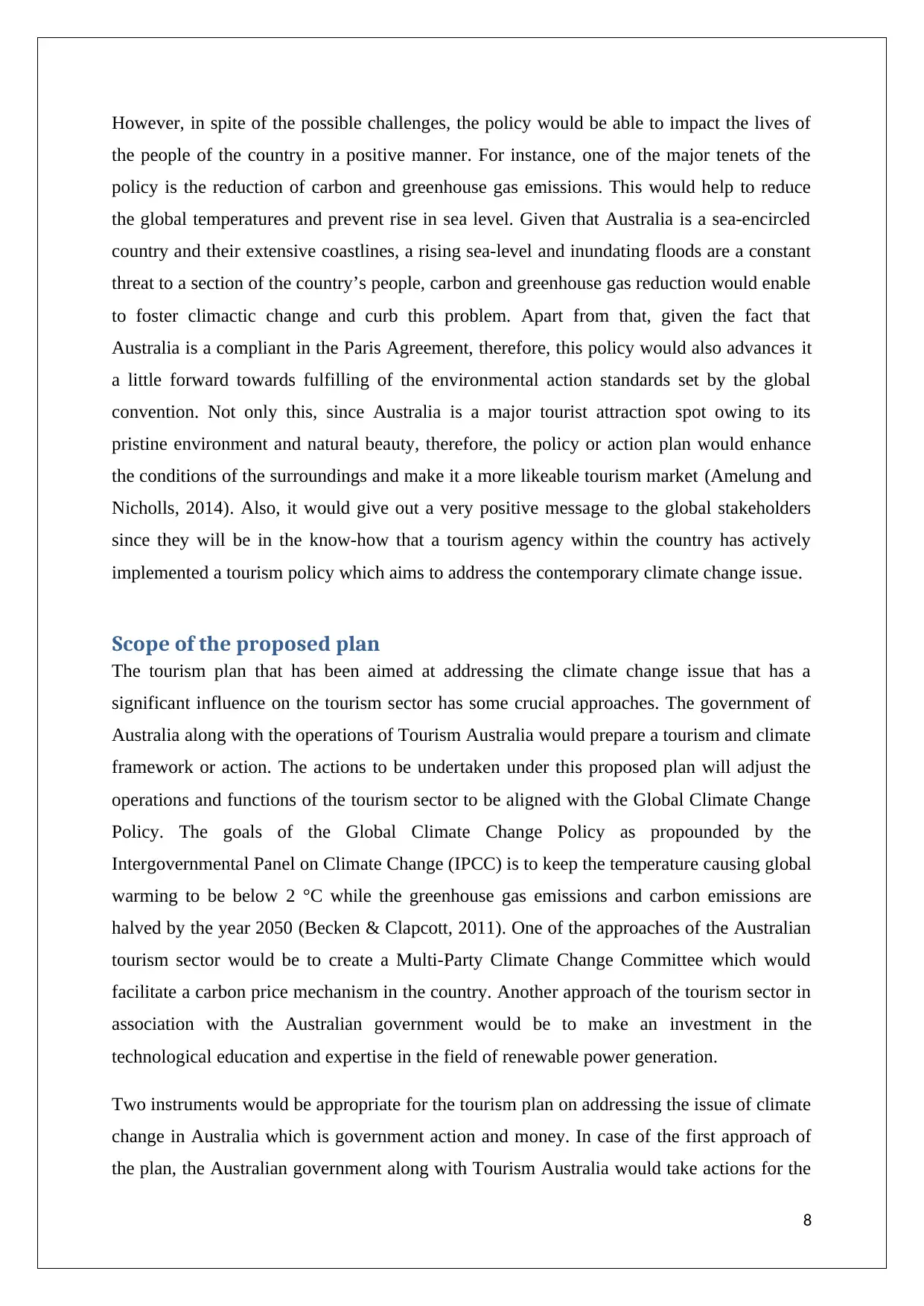
However, in spite of the possible challenges, the policy would be able to impact the lives of
the people of the country in a positive manner. For instance, one of the major tenets of the
policy is the reduction of carbon and greenhouse gas emissions. This would help to reduce
the global temperatures and prevent rise in sea level. Given that Australia is a sea-encircled
country and their extensive coastlines, a rising sea-level and inundating floods are a constant
threat to a section of the country’s people, carbon and greenhouse gas reduction would enable
to foster climactic change and curb this problem. Apart from that, given the fact that
Australia is a compliant in the Paris Agreement, therefore, this policy would also advances it
a little forward towards fulfilling of the environmental action standards set by the global
convention. Not only this, since Australia is a major tourist attraction spot owing to its
pristine environment and natural beauty, therefore, the policy or action plan would enhance
the conditions of the surroundings and make it a more likeable tourism market (Amelung and
Nicholls, 2014). Also, it would give out a very positive message to the global stakeholders
since they will be in the know-how that a tourism agency within the country has actively
implemented a tourism policy which aims to address the contemporary climate change issue.
Scope of the proposed plan
The tourism plan that has been aimed at addressing the climate change issue that has a
significant influence on the tourism sector has some crucial approaches. The government of
Australia along with the operations of Tourism Australia would prepare a tourism and climate
framework or action. The actions to be undertaken under this proposed plan will adjust the
operations and functions of the tourism sector to be aligned with the Global Climate Change
Policy. The goals of the Global Climate Change Policy as propounded by the
Intergovernmental Panel on Climate Change (IPCC) is to keep the temperature causing global
warming to be below 2 °C while the greenhouse gas emissions and carbon emissions are
halved by the year 2050 (Becken & Clapcott, 2011). One of the approaches of the Australian
tourism sector would be to create a Multi-Party Climate Change Committee which would
facilitate a carbon price mechanism in the country. Another approach of the tourism sector in
association with the Australian government would be to make an investment in the
technological education and expertise in the field of renewable power generation.
Two instruments would be appropriate for the tourism plan on addressing the issue of climate
change in Australia which is government action and money. In case of the first approach of
the plan, the Australian government along with Tourism Australia would take actions for the
8
the people of the country in a positive manner. For instance, one of the major tenets of the
policy is the reduction of carbon and greenhouse gas emissions. This would help to reduce
the global temperatures and prevent rise in sea level. Given that Australia is a sea-encircled
country and their extensive coastlines, a rising sea-level and inundating floods are a constant
threat to a section of the country’s people, carbon and greenhouse gas reduction would enable
to foster climactic change and curb this problem. Apart from that, given the fact that
Australia is a compliant in the Paris Agreement, therefore, this policy would also advances it
a little forward towards fulfilling of the environmental action standards set by the global
convention. Not only this, since Australia is a major tourist attraction spot owing to its
pristine environment and natural beauty, therefore, the policy or action plan would enhance
the conditions of the surroundings and make it a more likeable tourism market (Amelung and
Nicholls, 2014). Also, it would give out a very positive message to the global stakeholders
since they will be in the know-how that a tourism agency within the country has actively
implemented a tourism policy which aims to address the contemporary climate change issue.
Scope of the proposed plan
The tourism plan that has been aimed at addressing the climate change issue that has a
significant influence on the tourism sector has some crucial approaches. The government of
Australia along with the operations of Tourism Australia would prepare a tourism and climate
framework or action. The actions to be undertaken under this proposed plan will adjust the
operations and functions of the tourism sector to be aligned with the Global Climate Change
Policy. The goals of the Global Climate Change Policy as propounded by the
Intergovernmental Panel on Climate Change (IPCC) is to keep the temperature causing global
warming to be below 2 °C while the greenhouse gas emissions and carbon emissions are
halved by the year 2050 (Becken & Clapcott, 2011). One of the approaches of the Australian
tourism sector would be to create a Multi-Party Climate Change Committee which would
facilitate a carbon price mechanism in the country. Another approach of the tourism sector in
association with the Australian government would be to make an investment in the
technological education and expertise in the field of renewable power generation.
Two instruments would be appropriate for the tourism plan on addressing the issue of climate
change in Australia which is government action and money. In case of the first approach of
the plan, the Australian government along with Tourism Australia would take actions for the
8
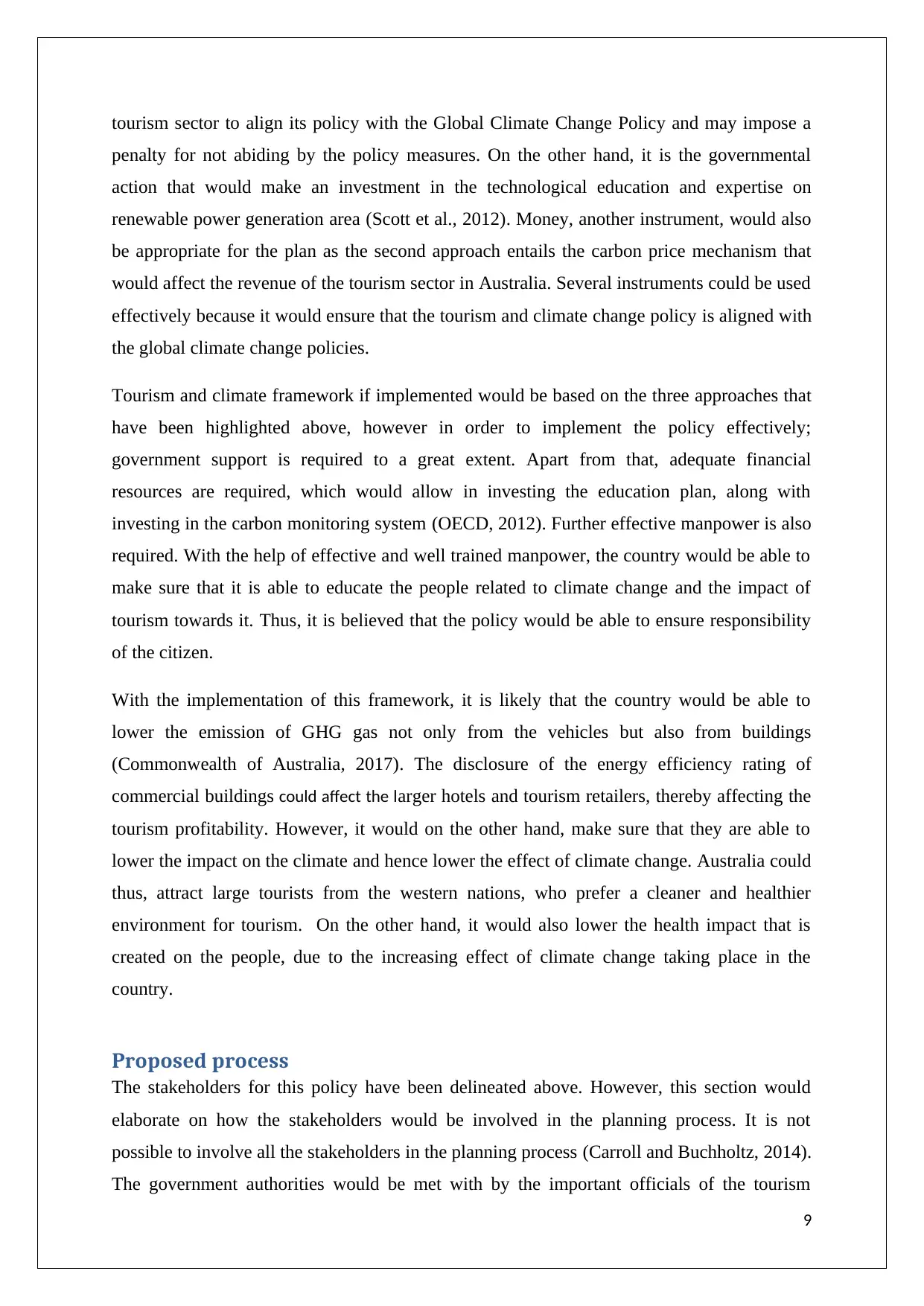
tourism sector to align its policy with the Global Climate Change Policy and may impose a
penalty for not abiding by the policy measures. On the other hand, it is the governmental
action that would make an investment in the technological education and expertise on
renewable power generation area (Scott et al., 2012). Money, another instrument, would also
be appropriate for the plan as the second approach entails the carbon price mechanism that
would affect the revenue of the tourism sector in Australia. Several instruments could be used
effectively because it would ensure that the tourism and climate change policy is aligned with
the global climate change policies.
Tourism and climate framework if implemented would be based on the three approaches that
have been highlighted above, however in order to implement the policy effectively;
government support is required to a great extent. Apart from that, adequate financial
resources are required, which would allow in investing the education plan, along with
investing in the carbon monitoring system (OECD, 2012). Further effective manpower is also
required. With the help of effective and well trained manpower, the country would be able to
make sure that it is able to educate the people related to climate change and the impact of
tourism towards it. Thus, it is believed that the policy would be able to ensure responsibility
of the citizen.
With the implementation of this framework, it is likely that the country would be able to
lower the emission of GHG gas not only from the vehicles but also from buildings
(Commonwealth of Australia, 2017). The disclosure of the energy efficiency rating of
commercial buildings could affect the larger hotels and tourism retailers, thereby affecting the
tourism profitability. However, it would on the other hand, make sure that they are able to
lower the impact on the climate and hence lower the effect of climate change. Australia could
thus, attract large tourists from the western nations, who prefer a cleaner and healthier
environment for tourism. On the other hand, it would also lower the health impact that is
created on the people, due to the increasing effect of climate change taking place in the
country.
Proposed process
The stakeholders for this policy have been delineated above. However, this section would
elaborate on how the stakeholders would be involved in the planning process. It is not
possible to involve all the stakeholders in the planning process (Carroll and Buchholtz, 2014).
The government authorities would be met with by the important officials of the tourism
9
penalty for not abiding by the policy measures. On the other hand, it is the governmental
action that would make an investment in the technological education and expertise on
renewable power generation area (Scott et al., 2012). Money, another instrument, would also
be appropriate for the plan as the second approach entails the carbon price mechanism that
would affect the revenue of the tourism sector in Australia. Several instruments could be used
effectively because it would ensure that the tourism and climate change policy is aligned with
the global climate change policies.
Tourism and climate framework if implemented would be based on the three approaches that
have been highlighted above, however in order to implement the policy effectively;
government support is required to a great extent. Apart from that, adequate financial
resources are required, which would allow in investing the education plan, along with
investing in the carbon monitoring system (OECD, 2012). Further effective manpower is also
required. With the help of effective and well trained manpower, the country would be able to
make sure that it is able to educate the people related to climate change and the impact of
tourism towards it. Thus, it is believed that the policy would be able to ensure responsibility
of the citizen.
With the implementation of this framework, it is likely that the country would be able to
lower the emission of GHG gas not only from the vehicles but also from buildings
(Commonwealth of Australia, 2017). The disclosure of the energy efficiency rating of
commercial buildings could affect the larger hotels and tourism retailers, thereby affecting the
tourism profitability. However, it would on the other hand, make sure that they are able to
lower the impact on the climate and hence lower the effect of climate change. Australia could
thus, attract large tourists from the western nations, who prefer a cleaner and healthier
environment for tourism. On the other hand, it would also lower the health impact that is
created on the people, due to the increasing effect of climate change taking place in the
country.
Proposed process
The stakeholders for this policy have been delineated above. However, this section would
elaborate on how the stakeholders would be involved in the planning process. It is not
possible to involve all the stakeholders in the planning process (Carroll and Buchholtz, 2014).
The government authorities would be met with by the important officials of the tourism
9
⊘ This is a preview!⊘
Do you want full access?
Subscribe today to unlock all pages.

Trusted by 1+ million students worldwide
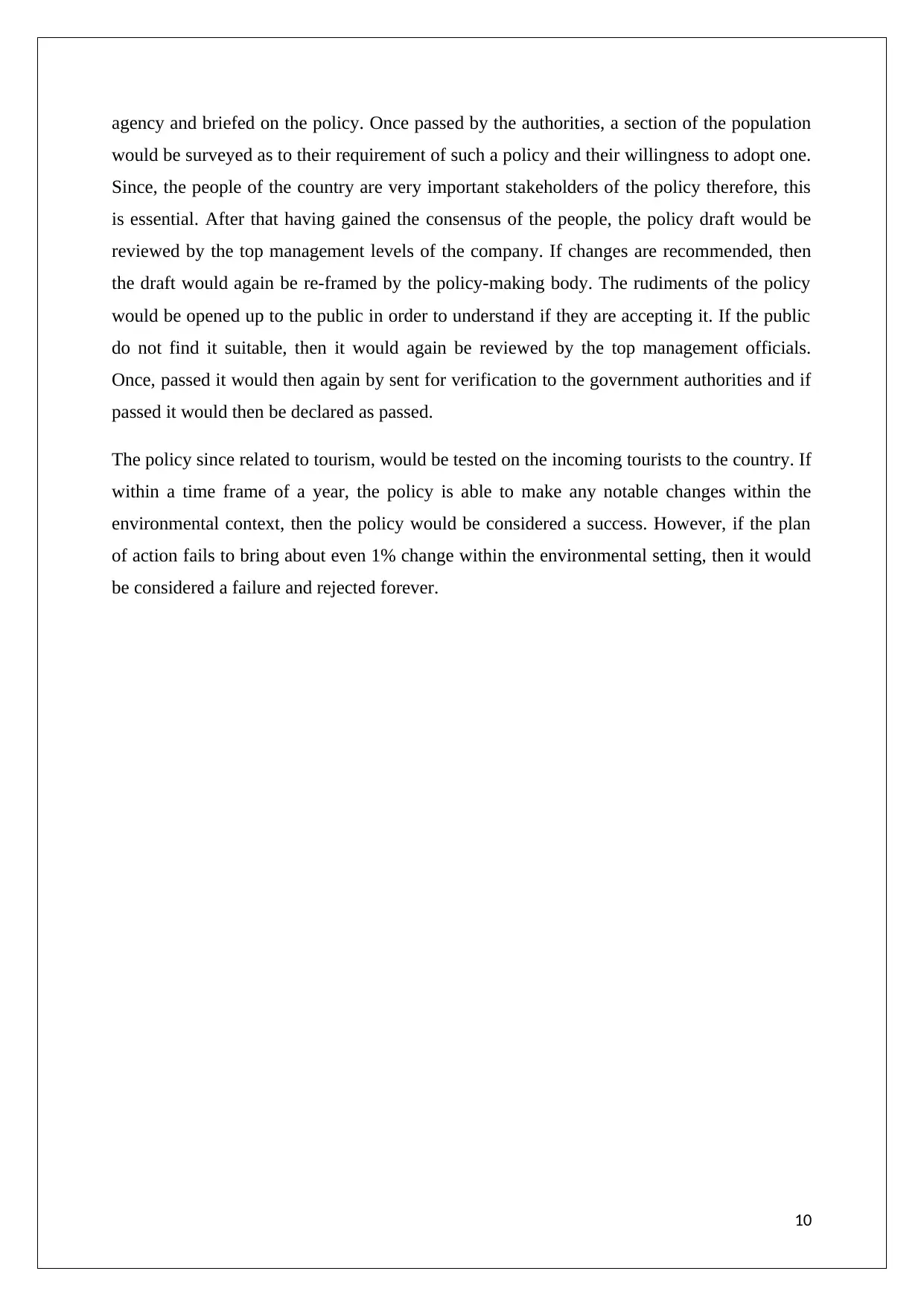
agency and briefed on the policy. Once passed by the authorities, a section of the population
would be surveyed as to their requirement of such a policy and their willingness to adopt one.
Since, the people of the country are very important stakeholders of the policy therefore, this
is essential. After that having gained the consensus of the people, the policy draft would be
reviewed by the top management levels of the company. If changes are recommended, then
the draft would again be re-framed by the policy-making body. The rudiments of the policy
would be opened up to the public in order to understand if they are accepting it. If the public
do not find it suitable, then it would again be reviewed by the top management officials.
Once, passed it would then again by sent for verification to the government authorities and if
passed it would then be declared as passed.
The policy since related to tourism, would be tested on the incoming tourists to the country. If
within a time frame of a year, the policy is able to make any notable changes within the
environmental context, then the policy would be considered a success. However, if the plan
of action fails to bring about even 1% change within the environmental setting, then it would
be considered a failure and rejected forever.
10
would be surveyed as to their requirement of such a policy and their willingness to adopt one.
Since, the people of the country are very important stakeholders of the policy therefore, this
is essential. After that having gained the consensus of the people, the policy draft would be
reviewed by the top management levels of the company. If changes are recommended, then
the draft would again be re-framed by the policy-making body. The rudiments of the policy
would be opened up to the public in order to understand if they are accepting it. If the public
do not find it suitable, then it would again be reviewed by the top management officials.
Once, passed it would then again by sent for verification to the government authorities and if
passed it would then be declared as passed.
The policy since related to tourism, would be tested on the incoming tourists to the country. If
within a time frame of a year, the policy is able to make any notable changes within the
environmental context, then the policy would be considered a success. However, if the plan
of action fails to bring about even 1% change within the environmental setting, then it would
be considered a failure and rejected forever.
10
Paraphrase This Document
Need a fresh take? Get an instant paraphrase of this document with our AI Paraphraser
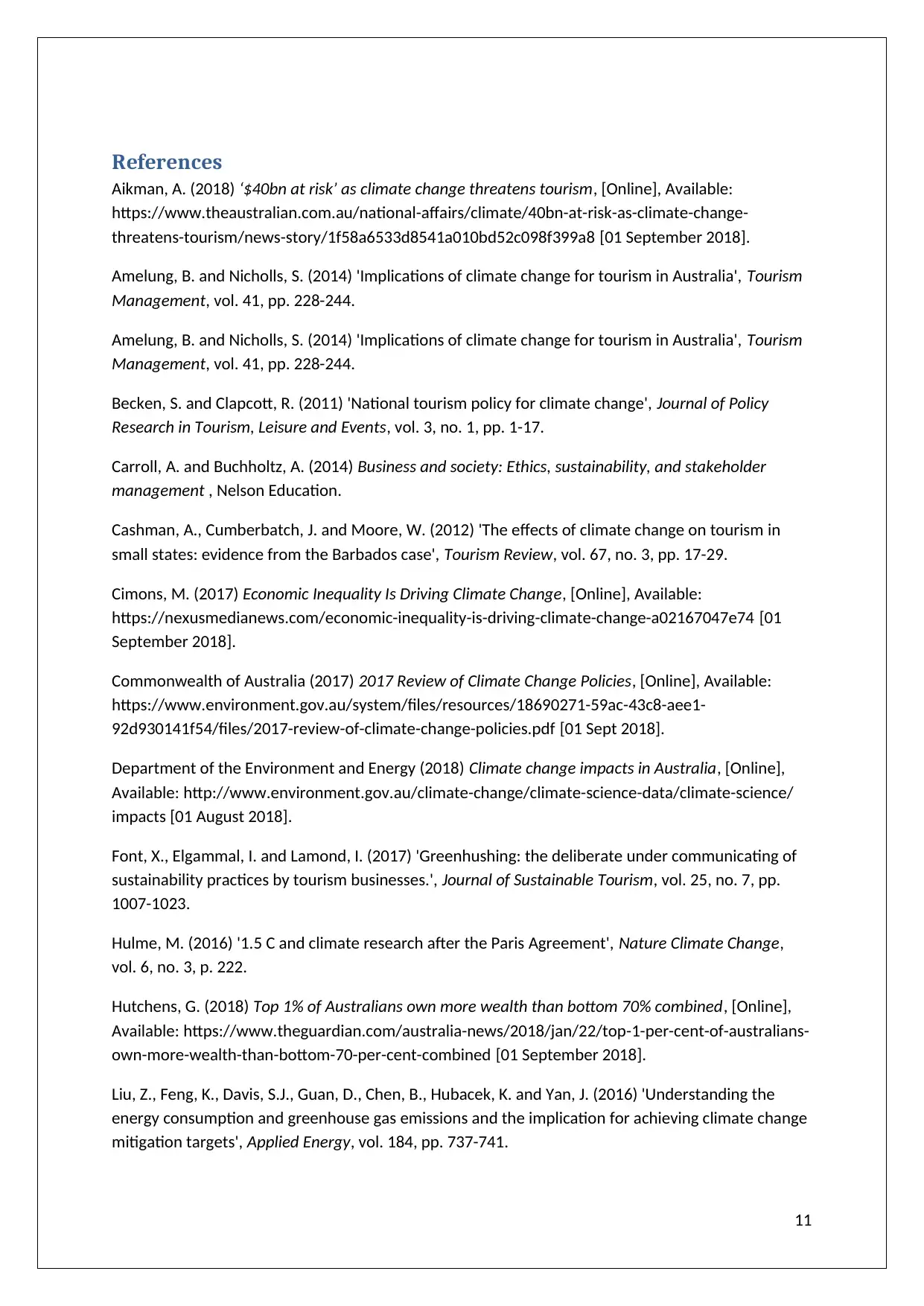
References
Aikman, A. (2018) ‘$40bn at risk’ as climate change threatens tourism, [Online], Available:
https://www.theaustralian.com.au/national-affairs/climate/40bn-at-risk-as-climate-change-
threatens-tourism/news-story/1f58a6533d8541a010bd52c098f399a8 [01 September 2018].
Amelung, B. and Nicholls, S. (2014) 'Implications of climate change for tourism in Australia', Tourism
Management, vol. 41, pp. 228-244.
Amelung, B. and Nicholls, S. (2014) 'Implications of climate change for tourism in Australia', Tourism
Management, vol. 41, pp. 228-244.
Becken, S. and Clapcott, R. (2011) 'National tourism policy for climate change', Journal of Policy
Research in Tourism, Leisure and Events, vol. 3, no. 1, pp. 1-17.
Carroll, A. and Buchholtz, A. (2014) Business and society: Ethics, sustainability, and stakeholder
management , Nelson Education.
Cashman, A., Cumberbatch, J. and Moore, W. (2012) 'The effects of climate change on tourism in
small states: evidence from the Barbados case', Tourism Review, vol. 67, no. 3, pp. 17-29.
Cimons, M. (2017) Economic Inequality Is Driving Climate Change, [Online], Available:
https://nexusmedianews.com/economic-inequality-is-driving-climate-change-a02167047e74 [01
September 2018].
Commonwealth of Australia (2017) 2017 Review of Climate Change Policies, [Online], Available:
https://www.environment.gov.au/system/files/resources/18690271-59ac-43c8-aee1-
92d930141f54/files/2017-review-of-climate-change-policies.pdf [01 Sept 2018].
Department of the Environment and Energy (2018) Climate change impacts in Australia, [Online],
Available: http://www.environment.gov.au/climate-change/climate-science-data/climate-science/
impacts [01 August 2018].
Font, X., Elgammal, I. and Lamond, I. (2017) 'Greenhushing: the deliberate under communicating of
sustainability practices by tourism businesses.', Journal of Sustainable Tourism, vol. 25, no. 7, pp.
1007-1023.
Hulme, M. (2016) '1.5 C and climate research after the Paris Agreement', Nature Climate Change,
vol. 6, no. 3, p. 222.
Hutchens, G. (2018) Top 1% of Australians own more wealth than bottom 70% combined, [Online],
Available: https://www.theguardian.com/australia-news/2018/jan/22/top-1-per-cent-of-australians-
own-more-wealth-than-bottom-70-per-cent-combined [01 September 2018].
Liu, Z., Feng, K., Davis, S.J., Guan, D., Chen, B., Hubacek, K. and Yan, J. (2016) 'Understanding the
energy consumption and greenhouse gas emissions and the implication for achieving climate change
mitigation targets', Applied Energy, vol. 184, pp. 737-741.
11
Aikman, A. (2018) ‘$40bn at risk’ as climate change threatens tourism, [Online], Available:
https://www.theaustralian.com.au/national-affairs/climate/40bn-at-risk-as-climate-change-
threatens-tourism/news-story/1f58a6533d8541a010bd52c098f399a8 [01 September 2018].
Amelung, B. and Nicholls, S. (2014) 'Implications of climate change for tourism in Australia', Tourism
Management, vol. 41, pp. 228-244.
Amelung, B. and Nicholls, S. (2014) 'Implications of climate change for tourism in Australia', Tourism
Management, vol. 41, pp. 228-244.
Becken, S. and Clapcott, R. (2011) 'National tourism policy for climate change', Journal of Policy
Research in Tourism, Leisure and Events, vol. 3, no. 1, pp. 1-17.
Carroll, A. and Buchholtz, A. (2014) Business and society: Ethics, sustainability, and stakeholder
management , Nelson Education.
Cashman, A., Cumberbatch, J. and Moore, W. (2012) 'The effects of climate change on tourism in
small states: evidence from the Barbados case', Tourism Review, vol. 67, no. 3, pp. 17-29.
Cimons, M. (2017) Economic Inequality Is Driving Climate Change, [Online], Available:
https://nexusmedianews.com/economic-inequality-is-driving-climate-change-a02167047e74 [01
September 2018].
Commonwealth of Australia (2017) 2017 Review of Climate Change Policies, [Online], Available:
https://www.environment.gov.au/system/files/resources/18690271-59ac-43c8-aee1-
92d930141f54/files/2017-review-of-climate-change-policies.pdf [01 Sept 2018].
Department of the Environment and Energy (2018) Climate change impacts in Australia, [Online],
Available: http://www.environment.gov.au/climate-change/climate-science-data/climate-science/
impacts [01 August 2018].
Font, X., Elgammal, I. and Lamond, I. (2017) 'Greenhushing: the deliberate under communicating of
sustainability practices by tourism businesses.', Journal of Sustainable Tourism, vol. 25, no. 7, pp.
1007-1023.
Hulme, M. (2016) '1.5 C and climate research after the Paris Agreement', Nature Climate Change,
vol. 6, no. 3, p. 222.
Hutchens, G. (2018) Top 1% of Australians own more wealth than bottom 70% combined, [Online],
Available: https://www.theguardian.com/australia-news/2018/jan/22/top-1-per-cent-of-australians-
own-more-wealth-than-bottom-70-per-cent-combined [01 September 2018].
Liu, Z., Feng, K., Davis, S.J., Guan, D., Chen, B., Hubacek, K. and Yan, J. (2016) 'Understanding the
energy consumption and greenhouse gas emissions and the implication for achieving climate change
mitigation targets', Applied Energy, vol. 184, pp. 737-741.
11
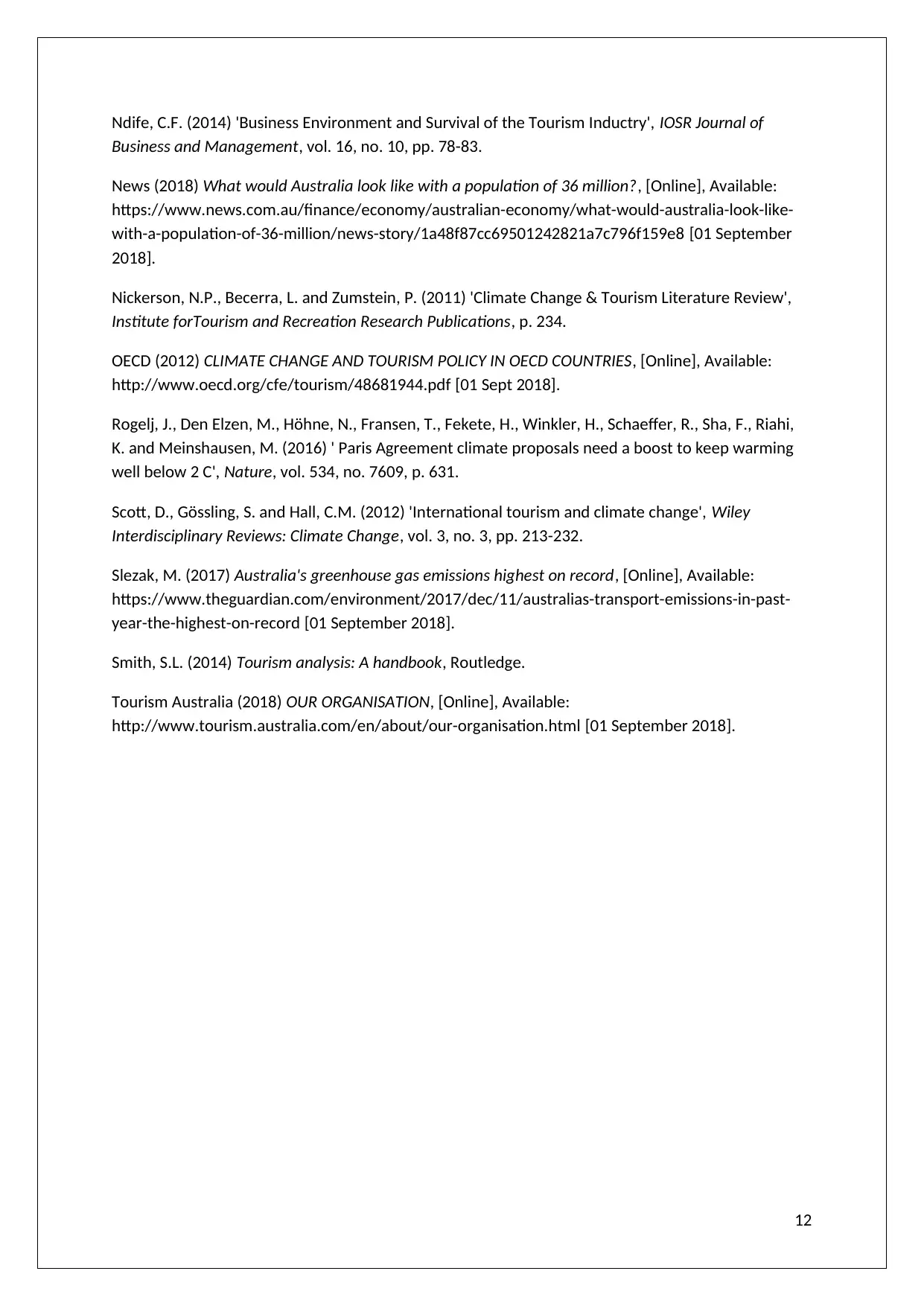
Ndife, C.F. (2014) 'Business Environment and Survival of the Tourism Inductry', IOSR Journal of
Business and Management, vol. 16, no. 10, pp. 78-83.
News (2018) What would Australia look like with a population of 36 million?, [Online], Available:
https://www.news.com.au/finance/economy/australian-economy/what-would-australia-look-like-
with-a-population-of-36-million/news-story/1a48f87cc69501242821a7c796f159e8 [01 September
2018].
Nickerson, N.P., Becerra, L. and Zumstein, P. (2011) 'Climate Change & Tourism Literature Review',
Institute forTourism and Recreation Research Publications, p. 234.
OECD (2012) CLIMATE CHANGE AND TOURISM POLICY IN OECD COUNTRIES, [Online], Available:
http://www.oecd.org/cfe/tourism/48681944.pdf [01 Sept 2018].
Rogelj, J., Den Elzen, M., Höhne, N., Fransen, T., Fekete, H., Winkler, H., Schaeffer, R., Sha, F., Riahi,
K. and Meinshausen, M. (2016) ' Paris Agreement climate proposals need a boost to keep warming
well below 2 C', Nature, vol. 534, no. 7609, p. 631.
Scott, D., Gössling, S. and Hall, C.M. (2012) 'International tourism and climate change', Wiley
Interdisciplinary Reviews: Climate Change, vol. 3, no. 3, pp. 213-232.
Slezak, M. (2017) Australia's greenhouse gas emissions highest on record, [Online], Available:
https://www.theguardian.com/environment/2017/dec/11/australias-transport-emissions-in-past-
year-the-highest-on-record [01 September 2018].
Smith, S.L. (2014) Tourism analysis: A handbook, Routledge.
Tourism Australia (2018) OUR ORGANISATION, [Online], Available:
http://www.tourism.australia.com/en/about/our-organisation.html [01 September 2018].
12
Business and Management, vol. 16, no. 10, pp. 78-83.
News (2018) What would Australia look like with a population of 36 million?, [Online], Available:
https://www.news.com.au/finance/economy/australian-economy/what-would-australia-look-like-
with-a-population-of-36-million/news-story/1a48f87cc69501242821a7c796f159e8 [01 September
2018].
Nickerson, N.P., Becerra, L. and Zumstein, P. (2011) 'Climate Change & Tourism Literature Review',
Institute forTourism and Recreation Research Publications, p. 234.
OECD (2012) CLIMATE CHANGE AND TOURISM POLICY IN OECD COUNTRIES, [Online], Available:
http://www.oecd.org/cfe/tourism/48681944.pdf [01 Sept 2018].
Rogelj, J., Den Elzen, M., Höhne, N., Fransen, T., Fekete, H., Winkler, H., Schaeffer, R., Sha, F., Riahi,
K. and Meinshausen, M. (2016) ' Paris Agreement climate proposals need a boost to keep warming
well below 2 C', Nature, vol. 534, no. 7609, p. 631.
Scott, D., Gössling, S. and Hall, C.M. (2012) 'International tourism and climate change', Wiley
Interdisciplinary Reviews: Climate Change, vol. 3, no. 3, pp. 213-232.
Slezak, M. (2017) Australia's greenhouse gas emissions highest on record, [Online], Available:
https://www.theguardian.com/environment/2017/dec/11/australias-transport-emissions-in-past-
year-the-highest-on-record [01 September 2018].
Smith, S.L. (2014) Tourism analysis: A handbook, Routledge.
Tourism Australia (2018) OUR ORGANISATION, [Online], Available:
http://www.tourism.australia.com/en/about/our-organisation.html [01 September 2018].
12
⊘ This is a preview!⊘
Do you want full access?
Subscribe today to unlock all pages.

Trusted by 1+ million students worldwide
1 out of 12
Related Documents
Your All-in-One AI-Powered Toolkit for Academic Success.
+13062052269
info@desklib.com
Available 24*7 on WhatsApp / Email
![[object Object]](/_next/static/media/star-bottom.7253800d.svg)
Unlock your academic potential
Copyright © 2020–2025 A2Z Services. All Rights Reserved. Developed and managed by ZUCOL.



